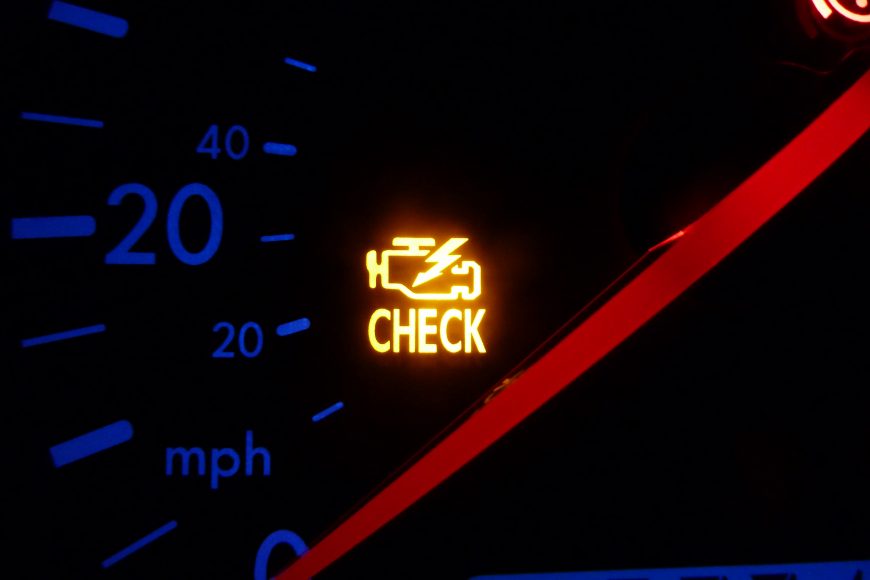- January 30, 2018
- By Southern Autobody
- In blog
- 2242
- 0

As you’re driving home from work your worst nightmare as a vehicle owner comes true – the check engine light comes on! Usually, without any warning or explanation, it can be quite an unsettling experience.
Often just a light, with no additional information, you are often at a loss for what the problem is. Unfortunately for most drivers, this means a trip the mechanic. Thankfully, there are a few things you can do yourself to help diagnose the issue before heading for repairs.
A check engine can indicate a major problem that requires the stopping of your vehicle immediately to avoid costly engine repair. But, it can also be triggered by a number of minor issues. This is one of the reasons the generic function of the check engine light can be so frustrating.
Unless your car starts smoking, or stalls completely, you are most likely ok to finish the short drive home or to the nearest auto repair shop. Once stopped, you can run diagnostics to determine the cause of the check engine light.
Most often a check engine light does not indicate a severe issue. As long as the issue is resolved within a reasonable period of time, your vehicle shouldn’t suffer any long-term or permanent damage.
The key to ensuring that no permanent or costly damage is inflicted is to diagnose what has caused the check engine light to illuminate.
Below we have compiled the 5 most common malfunctions that could cause your check engine light to come on:
According to NAPA Canada, the most common cause for Check Engine light illumination is an oxygen sensor.
Your oxygen sensor measures the amount of unburned oxygen traveling through your vehicles exhaust system. It effectively monitors the amount of fuel being burned. A faulty sensor will provide incorrect data to your vehicles ECU, which can cause a decrease in gas mileage.
Most modern cars have from 2-4 O2 sensors and a simple scan of your onboard diagnostics system will reveal a related code letting you know which one needs replacing.
Not everyone realizes how important the function of a gas cap really is. Your gas cap seals the fuel system and helps to maintain the correct pressure within the fuel tank. Furthermore, it prevents harmful fumes from being released into the air while your vehicle is not in operation.
When your gas cap is loose, damaged or missing altogether, these vapors can actually throw your entire fuel system off. Again, you may experience an increase in emissions and reduced gas mileage. If your check engine comes on, one of the first things to do is check the gas cap.
The ignition system plays a critical role in the operation of your vehicle. Spark plugs seal the combustion chamber within your engine and ignite the air-fuel mixture.
When spark plugs or spark plug wires are failing there could be a misfire. Often this will cause a jolt in your car’s acceleration or a rough idle.
Even though spark plugs are designed to last upwards of 50,000km, they can fail sooner. Check what kind of plugs you have to determine how often they need to be replaced, and if you start noticing any of the above symptoms, have them replaced.
Spark plugs are relatively inexpensive and replacing them can help prevent more costly repairs.
The mass airflow sensor reads the amount and temperature of air flowing across it. It then tells your vehicles computer what amount of fuel to add based on the air coming through the engine. The purpose of your MAF sensor is to determine how much fuel is needed to run your engine as efficiently as possible.
Faulty MAF sensors can cause increased emissions, stalls, and decreased gas mileage. Unfortunately, the MAF sensor can trigger a check engine light for a multitude of reasons. The real issue is that the associated issues can range from simple annoyances to issues requiring immediate attention.
Because of the number of potential causes, and the varying severity of these issues, diagnosing a faulty MAF sensor normally requires the services of a professional mechanic.
Your vehicles catalytic converter works to reduce exhaust gases and protect the environment. By converting harmful carbon monoxide and other harmful materials into harmless compounds your catalytic converter is very important.
If your catalytic converter is failing you will most likely get a check engine light, see a reduction in gas mileage, and feel a loss of power. Most often damage to a catalytic converter is caused by neglected maintenance (Spark Plugs/Wires, O2 sensor, MAF sensor).
Leaving a failing catalytic converter un-repaired can have a major impact on the day-to-day operation of your vehicle. Not only can these issues result in misfiring, but they can result in your vehicle stalling and not restarting.
If you suspect your catalytic converter may be failing we recommend making an appointment and bringing your vehicle into Southern Auto Body for professional diagnosis and repair.
Having a checking engine light pop up is not ideal, however, it does not always mean you need to pull over and call a tow-truck.
There are many possible reasons for a check engine light to become illuminated, but the 5 listed above are by far the most common.
It is important that you do not ignore a check engine light, as underlying issues will worsen and can cause you to become stranded – with a hefty repair bill.
Always keep up on your maintenance and remember that all vehicles benefit from being taken care of. The best way to diagnose your check engine light is to keep it off altogether.
If your check engine light is on, you need service, or you just want to keep up to date on your maintenance, contact Southern Auto Body today to book your appointment.


